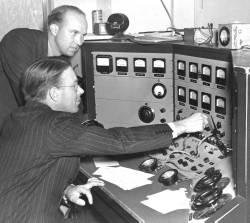John Hundale Lawrence was an American physician and a pioneer in the field of nuclear medicine.
Lawrence received his B.S. in Chemistry from the University of South Dakota in 1926 and graduated from Harvard Medical School in 1930, where he studied with neurosurgeon Harvey Cushing. He then became an instructor in medicine at Yale University, where he studied the pituitary gland’s response to radiation.
In 1935, Lawrence joined his brother Ernest at the University of California, Berkeley. There John began to study the biochemical and medical effects of the radioactive products emitted from his brother’s cyclotron. This included experiments with high-energy neutrons and radioactive isotopes.
The lab’s main focus initially was in developing tracer molecules, radioactive isotopes bound to common biological structures, to track metabolism and treat disease. Lawrence and his team, which later became the Donner Laboratory at Berkeley, also investigated using a neutron beam as a treatment for tumors. The group used phosphorous-32 to treat leukemia and iodine-131 to study the thyroid glands. The lab also helped produce many radioactive isotopes that have since become common in nuclear medicine.
During World War II, John studied high-altitude physiology, in an effort to help fighter pilots whose cabins weren’t pressurized. After the war, he continued his exploration into the use of radioactive materials in the treatment of disease.
In 1955, Lawrence was sent as part of the American delegation to the Geneva conference on peaceful uses of the atom. He received a Guggenheim Fellowship in physics in 1957. Lawrence retired as director of the Donner Laboratory in 1970, and then spent the next thirteen years as a Regent of the University of California. He received the Enrico Fermi Award in 1983 from the United States Department of Energy for his work in nuclear medicine.
John Lawrence died on September 7, 1991, at the age of 87.





